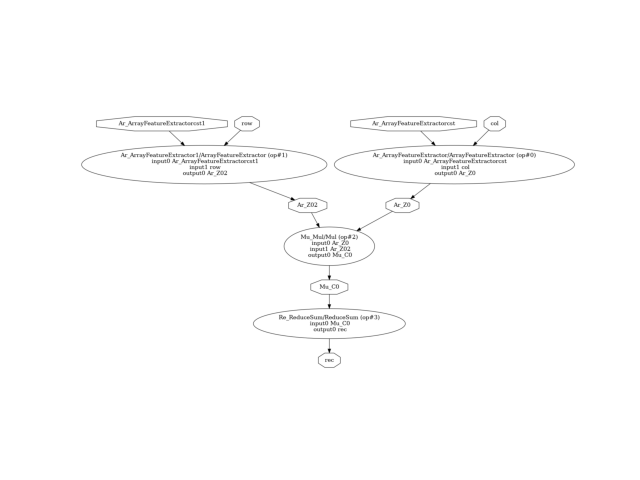注意
转到末尾 下载完整的示例代码。
NMF 分解的自定义算子¶
NMF 将输入矩阵分解为两个秩为 k 的矩阵 W, H,使得  。
。  可以是一个二元矩阵,其中 i 代表用户,j 代表他购买的产品。预测函数取决于用户是需要为现有用户还是新用户进行推荐。本示例处理第一种情况。
可以是一个二元矩阵,其中 i 代表用户,j 代表他购买的产品。预测函数取决于用户是需要为现有用户还是新用户进行推荐。本示例处理第一种情况。
第二种情况更复杂,因为它理论上需要通过梯度下降来估计一个新的矩阵 W。
构建一个简单的模型¶
import os
import skl2onnx
import onnxruntime
import sklearn
from sklearn.decomposition import NMF
import numpy as np
import matplotlib.pyplot as plt
from onnx.tools.net_drawer import GetPydotGraph, GetOpNodeProducer
import onnx
from skl2onnx.algebra.onnx_ops import OnnxArrayFeatureExtractor, OnnxMul, OnnxReduceSum
from skl2onnx.common.data_types import FloatTensorType
from onnxruntime import InferenceSession
mat = np.array(
[[1, 0, 0, 0], [1, 0, 0, 0], [1, 0, 0, 0], [1, 0, 0, 0], [1, 0, 0, 0]],
dtype=np.float64,
)
mat[: mat.shape[1], :] += np.identity(mat.shape[1])
mod = NMF(n_components=2)
W = mod.fit_transform(mat)
H = mod.components_
pred = mod.inverse_transform(W)
print("original predictions")
exp = []
for i in range(mat.shape[0]):
for j in range(mat.shape[1]):
exp.append((i, j, pred[i, j]))
print(exp)
original predictions
[(0, 0, np.float64(1.8940619439633473)), (0, 1, np.float64(0.3072432913109815)), (0, 2, np.float64(0.1091000464503179)), (0, 3, np.float64(0.3072432913109815)), (1, 0, np.float64(1.1066037222104155)), (1, 1, np.float64(0.19083096278248987)), (1, 2, np.float64(0.0)), (1, 3, np.float64(0.19083096278248987)), (2, 0, np.float64(1.014668907902116)), (2, 1, np.float64(0.0)), (2, 2, np.float64(0.9848932612757917)), (2, 3, np.float64(0.0)), (3, 0, np.float64(1.1066037222104155)), (3, 1, np.float64(0.19083096278248987)), (3, 2, np.float64(0.0)), (3, 3, np.float64(0.19083096278248987)), (4, 0, np.float64(0.9470309719816736)), (4, 1, np.float64(0.15362164565549075)), (4, 2, np.float64(0.05455002322515895)), (4, 3, np.float64(0.15362164565549075))]
让我们改写预测函数,使其更接近我们需要转换为 ONNX 的函数。
[(0, 0, np.float64(1.8940619439633473)), (0, 1, np.float64(0.3072432913109815)), (0, 2, np.float64(0.1091000464503179)), (0, 3, np.float64(0.3072432913109815)), (1, 0, np.float64(1.1066037222104155)), (1, 1, np.float64(0.19083096278248987)), (1, 2, np.float64(0.0)), (1, 3, np.float64(0.19083096278248987)), (2, 0, np.float64(1.014668907902116)), (2, 1, np.float64(0.0)), (2, 2, np.float64(0.9848932612757917)), (2, 3, np.float64(0.0)), (3, 0, np.float64(1.1066037222104155)), (3, 1, np.float64(0.19083096278248987)), (3, 2, np.float64(0.0)), (3, 3, np.float64(0.19083096278248987)), (4, 0, np.float64(0.9470309719816736)), (4, 1, np.float64(0.15362164565549075)), (4, 2, np.float64(0.05455002322515895)), (4, 3, np.float64(0.15362164565549075))]
转换为 ONNX¶
目前没有实现 NMF 的转换器,因为我们计划转换的函数既不是 transformer 也不是 predictor。下面的转换器不需要注册,它只是创建一个等同于上面实现的 predict 函数的 ONNX 图。
def nmf_to_onnx(W, H, op_version=12):
"""
The function converts a NMF described by matrices
*W*, *H* (*WH* approximate training data *M*).
into a function which takes two indices *(i, j)*
and returns the predictions for it. It assumes
these indices applies on the training data.
"""
col = OnnxArrayFeatureExtractor(H, "col")
row = OnnxArrayFeatureExtractor(W.T, "row")
dot = OnnxMul(col, row, op_version=op_version)
res = OnnxReduceSum(dot, output_names="rec", op_version=op_version)
indices_type = np.array([0], dtype=np.int64)
onx = res.to_onnx(
inputs={"col": indices_type, "row": indices_type},
outputs=[("rec", FloatTensorType((None, 1)))],
target_opset=op_version,
)
return onx
model_onnx = nmf_to_onnx(W.astype(np.float32), H.astype(np.float32))
print(model_onnx)
ir_version: 7
producer_name: "skl2onnx"
producer_version: "1.19.1"
domain: "ai.onnx"
model_version: 0
graph {
node {
input: "Ar_ArrayFeatureExtractorcst"
input: "col"
output: "Ar_Z0"
name: "Ar_ArrayFeatureExtractor"
op_type: "ArrayFeatureExtractor"
domain: "ai.onnx.ml"
}
node {
input: "Ar_ArrayFeatureExtractorcst1"
input: "row"
output: "Ar_Z02"
name: "Ar_ArrayFeatureExtractor1"
op_type: "ArrayFeatureExtractor"
domain: "ai.onnx.ml"
}
node {
input: "Ar_Z0"
input: "Ar_Z02"
output: "Mu_C0"
name: "Mu_Mul"
op_type: "Mul"
domain: ""
}
node {
input: "Mu_C0"
output: "rec"
name: "Re_ReduceSum"
op_type: "ReduceSum"
domain: ""
}
name: "OnnxReduceSum"
initializer {
dims: 2
dims: 4
data_type: 1
float_data: 1.97398615
float_data: 0.340408832
float_data: 0
float_data: 0.340408832
float_data: 0.89287746
float_data: 0
float_data: 0.866675794
float_data: 0
name: "Ar_ArrayFeatureExtractorcst"
}
initializer {
dims: 2
dims: 5
data_type: 1
float_data: 0.90257144
float_data: 0.560593426
float_data: 0
float_data: 0.560593426
float_data: 0.45128572
float_data: 0.125883341
float_data: 0
float_data: 1.13640332
float_data: 0
float_data: 0.0629416704
name: "Ar_ArrayFeatureExtractorcst1"
}
input {
name: "col"
type {
tensor_type {
elem_type: 7
shape {
dim {
}
}
}
}
}
input {
name: "row"
type {
tensor_type {
elem_type: 7
shape {
dim {
}
}
}
}
}
output {
name: "rec"
type {
tensor_type {
elem_type: 1
shape {
dim {
}
dim {
dim_value: 1
}
}
}
}
}
}
opset_import {
domain: ""
version: 12
}
opset_import {
domain: "ai.onnx.ml"
version: 1
}
让我们用它来计算预测。
sess = InferenceSession(
model_onnx.SerializeToString(), providers=["CPUExecutionProvider"]
)
def predict_onnx(sess, row_indices, col_indices):
res = sess.run(None, {"col": col_indices, "row": row_indices})
return res
onnx_preds = []
for i in range(mat.shape[0]):
for j in range(mat.shape[1]):
row_indices = np.array([i], dtype=np.int64)
col_indices = np.array([j], dtype=np.int64)
pred = predict_onnx(sess, row_indices, col_indices)[0]
onnx_preds.append((i, j, pred[0, 0]))
print(onnx_preds)
[(0, 0, np.float32(1.8940619)), (0, 1, np.float32(0.3072433)), (0, 2, np.float32(0.109100044)), (0, 3, np.float32(0.3072433)), (1, 0, np.float32(1.1066036)), (1, 1, np.float32(0.19083095)), (1, 2, np.float32(0.0)), (1, 3, np.float32(0.19083095)), (2, 0, np.float32(1.014669)), (2, 1, np.float32(0.0)), (2, 2, np.float32(0.98489326)), (2, 3, np.float32(0.0)), (3, 0, np.float32(1.1066036)), (3, 1, np.float32(0.19083095)), (3, 2, np.float32(0.0)), (3, 3, np.float32(0.19083095)), (4, 0, np.float32(0.94703096)), (4, 1, np.float32(0.15362164)), (4, 2, np.float32(0.054550022)), (4, 3, np.float32(0.15362164))]
ONNX 图如下所示。
pydot_graph = GetPydotGraph(
model_onnx.graph,
name=model_onnx.graph.name,
rankdir="TB",
node_producer=GetOpNodeProducer("docstring"),
)
pydot_graph.write_dot("graph_nmf.dot")
os.system("dot -O -Tpng graph_nmf.dot")
image = plt.imread("graph_nmf.dot.png")
plt.imshow(image)
plt.axis("off")

(np.float64(-0.5), np.float64(1654.5), np.float64(846.5), np.float64(-0.5))
此示例使用的版本
print("numpy:", np.__version__)
print("scikit-learn:", sklearn.__version__)
print("onnx: ", onnx.__version__)
print("onnxruntime: ", onnxruntime.__version__)
print("skl2onnx: ", skl2onnx.__version__)
numpy: 2.3.1
scikit-learn: 1.6.1
onnx: 1.19.0
onnxruntime: 1.23.0
skl2onnx: 1.19.1
脚本总运行时间: (0 分钟 0.454 秒)